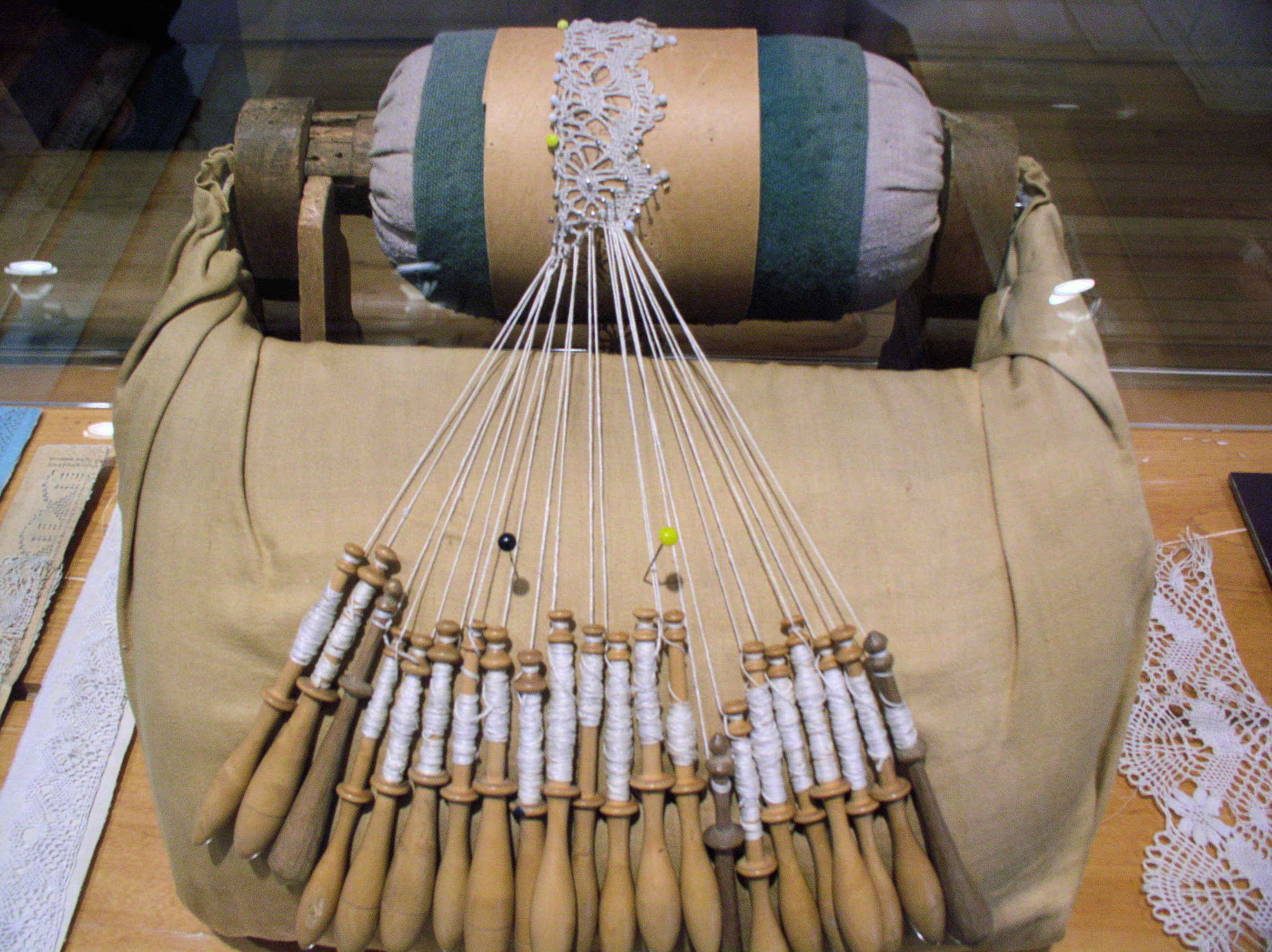|
Caterina Angiola Pieroncini
Caterina Angiola Pieroncini was a 17th-century Italian lace-maker, embroiderer and lady-in-waiting for the Grand Duchess Vittoria della Rovere. Career As a lady-in-waiting to the Grand Duchess Vittoria della Rovere (1622–1694) who was known for supporting her ladies in waiting, Pieroncini was sent to Paris in 1664 to study needlework in order to make the latest designs, after which she returned to Florence. While in Paris, Maria of Lorraine, the duchess of Switzerland, was her guardian. Pieroncini studied under the direction of Mademoiselle Alée in Paris for eighteen months, during which she was paid 200 lire every two trimesters plus other costs of living. As a lace-maker, Pieroncini worked during a time when Venetian ''gros point'' needle lace was in vogue and was considered the highest quality lace. By the mid-century, French styles of bobbin lace Bobbin lace is a lace textile made by braiding and twisting lengths of yarn, thread, which are wound on #Bobbins, bobbins ... [...More Info...] [...Related Items...] OR: [Wikipedia] [Google] [Baidu] |
Lady-in-waiting
A lady-in-waiting (alternatively written lady in waiting) or court lady is a female personal assistant at a Royal court, court, attending on a royal woman or a high-ranking nobility, noblewoman. Historically, in Europe, a lady-in-waiting was often a noblewoman but of lower rank than the woman to whom she attended. Although she may either have received a Retainer agreement, retainer or may not have received compensation for the service she rendered, a lady-in-waiting was considered more of a personal assistant, secretary, courtier, or Lady's companion, companion to her Mistress (form of address), mistress than a domestic worker, servant. In some other parts of the world, the lady-in-waiting, often referred to as ''palace woman'', was in practice a servant or a slave rather than a high-ranking woman, but still had about the same tasks, functioning as companion and secretary to her mistress. In courts where polygamy was practiced, a court lady might have been formally available to ... [...More Info...] [...Related Items...] OR: [Wikipedia] [Google] [Baidu] |
Vittoria Della Rovere
Vittoria della Rovere (7 February 1622 – 5 March 1694) was Grand Duchess of Tuscany as the wife of Grand Duke Ferdinando II. She had four children with her husband, two of whom would survive infancy: the future Cosimo III, Tuscany's longest-reigning monarch, and Francesco Maria, a prince of the Church. At the death of her grandfather Francesco Maria della Rovere, she inherited the Duchies of Rovere and Montefeltro, which reverted to her second son, Francesco Maria, at her death. She was later entrusted with the care of her three grandchildren. Her marriage brought a wealth of treasures to the House of Medici, which can today be seen in the Palazzo Pitti and the Uffizi Gallery in Florence. Infancy Vittoria della Rovere was the only child of Federico Ubaldo della Rovere, son of the then incumbent Duke of Urbino, Francesco Maria. Her mother was Claudia de' Medici, a sister of Cosimo II de' Medici, Grand Duke of Tuscany and the Duchess of Mantua. As an infant it was expe ... [...More Info...] [...Related Items...] OR: [Wikipedia] [Google] [Baidu] |
Lady-in-waiting
A lady-in-waiting (alternatively written lady in waiting) or court lady is a female personal assistant at a Royal court, court, attending on a royal woman or a high-ranking nobility, noblewoman. Historically, in Europe, a lady-in-waiting was often a noblewoman but of lower rank than the woman to whom she attended. Although she may either have received a Retainer agreement, retainer or may not have received compensation for the service she rendered, a lady-in-waiting was considered more of a personal assistant, secretary, courtier, or Lady's companion, companion to her Mistress (form of address), mistress than a domestic worker, servant. In some other parts of the world, the lady-in-waiting, often referred to as ''palace woman'', was in practice a servant or a slave rather than a high-ranking woman, but still had about the same tasks, functioning as companion and secretary to her mistress. In courts where polygamy was practiced, a court lady might have been formally available to ... [...More Info...] [...Related Items...] OR: [Wikipedia] [Google] [Baidu] |
Needle Lace
Needle lace is a type of lace created using a needle and thread to create hundreds of small stitches to form the lace itself. Origins The origins of needle lace date back to the 15th century and embroidery. Cutwork and drawn work were developed to add interest to white on white embroidery, and the methods used in these techniques led to needle lace. A second expert puts the development of needle lace in the following century, the 16th, in Italy, also stemming from embroidery, the openwork on linen technique called '' reticella''. To show off their wealth in that period in Italy, the aristocracy favored wearing rich cloth embellished by embroidery and braid. As the century progressed, the small areas that were cut from the fabric to highlight the needle lace were replaced by much larger areas of cutwork. The needlework was dependent on remaining threads running vertically and horizontally, leaving squares and rectangles, which led to geometric designs. Venice was a cente ... [...More Info...] [...Related Items...] OR: [Wikipedia] [Google] [Baidu] |
Bobbin Lace
Bobbin lace is a lace textile made by braiding and twisting lengths of yarn, thread, which are wound on #Bobbins, bobbins to manage them. As the work progresses, the weaving is held in place with pins set in a lace pillow, the placement of the pins usually determined by a pattern or pricking pinned on the pillow. Bobbin lace is also known as pillow lace, because it was worked on a pillow, and bone lace, because early bobbins were made of bone or ivory. Bobbin lace is one of the two major categories of handmade laces, the other being needle lace, derived from earlier cutwork and reticella. Origin A will of 1493 by the Milanese House of Sforza, Sforza family mentions lace created with twelve bobbins. There are two books that represent the early known pattern descriptions for bobbin lace, ''Le Pompe'' from Venice and ''Nüw Modelbuch'' from Zürich. Other popular lace pattern books were produced by Isabella Parasole, which included patterns for reticella, needle lace and bobbin ... [...More Info...] [...Related Items...] OR: [Wikipedia] [Google] [Baidu] |
Italian Embroiderers
Italian(s) may refer to: * Anything of, from, or related to the people of Italy over the centuries ** Italians, a Romance ethnic group related to or simply a citizen of the Italian Republic or Italian Kingdom ** Italian language, a Romance language *** Regional Italian, regional variants of the Italian language ** Languages of Italy, languages and dialects spoken in Italy ** Italian culture, cultural features of Italy ** Italian cuisine, traditional foods ** Folklore of Italy, the folklore and urban legends of Italy ** Mythology of Italy, traditional religion and beliefs Other uses * Italian dressing, a vinaigrette-type salad dressing or marination * Italian or Italian-A, alternative names for the Ping-Pong virus, an extinct computer virus * ''Italien'' (magazine), pro-Fascist magazine in Germany between 1927 and 1944 See also * * * Italia (other) * Italic (other) * Italo (other) * The Italian (other) * Italian people (other) Italian ... [...More Info...] [...Related Items...] OR: [Wikipedia] [Google] [Baidu] |
17th-century Italian Women Artists
The 17th century lasted from January 1, 1601 (represented by the Roman numerals MDCI), to December 31, 1700 (MDCC). It falls into the early modern period of Europe and in that continent (whose impact on the world was increasing) was characterized by the Baroque cultural movement, the latter part of the Spanish Golden Age, the Dutch Golden Age, the French ''Grand Siècle'' dominated by Louis XIV, the Scientific Revolution, the world's first public company and megacorporation known as the Dutch East India Company, and according to some historians, the General Crisis. From the mid-17th century, European politics were increasingly dominated by the Kingdom of France of Louis XIV, where royal power was solidified domestically in the civil war of the Fronde. The semi-feudal territorial French nobility was weakened and subjugated to the power of an absolute monarchy through the reinvention of the Palace of Versailles from a hunting lodge to a gilded prison, in which a greatly expanded ro ... [...More Info...] [...Related Items...] OR: [Wikipedia] [Google] [Baidu] |





